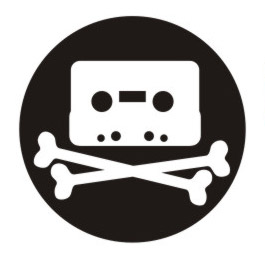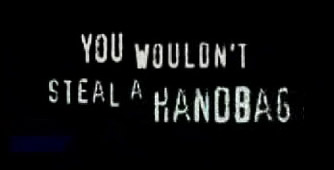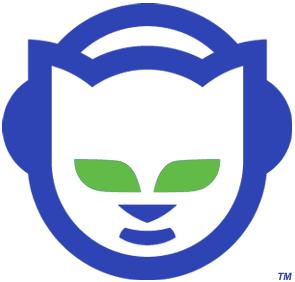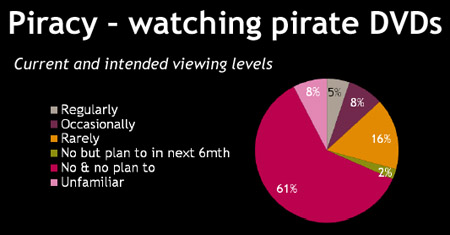May 28, 2008
Piracy and the Free Market
 The free market, as the reasoning goes, is a wonderful example of a self-balancing system. Vendors try to charge as much as possible, consumers try to pay as little as possible, competition helps to drive prices down, and the whole thing just sort of works itself out, naturally finding the appropriate price for everything you’d ever need.
The free market, as the reasoning goes, is a wonderful example of a self-balancing system. Vendors try to charge as much as possible, consumers try to pay as little as possible, competition helps to drive prices down, and the whole thing just sort of works itself out, naturally finding the appropriate price for everything you’d ever need.
It would take more than the unlimited space than I have here to debate the merits of the unfettered market. What I believe needs no debate is that there are times when the free market breaks down. The very existence of antitust laws makes this obvious; a free market is wonderful in theory, but when it leads to monopolies or cartels, the usual balance of supply and demand that strikes a balance “naturally” ceases to exist. Especially when it comes to items which have their prices inflated artificially, by controlling the supply to the consumer, the price does not reflect the “true” value of the item, from a free market point of view.
The methods (and reasons) for controlling supply vary. Diamonds are controlled solely to create a false scarcity, driving prices up. With something like oil, for example, production is limited not only to maximise profit, but also because the production, refinement, and distribution of the finite supply of the earth’s oil has to be regulated in order to avoid consumption levels that outstrip availability, which would drive prices up, and lead to yo-yoing prices; flooding the market by producing at full capacity would provide lots of cheap gas in the short term, but would lead to disastrous consequences in the long term. Other limited resources, like fish stocks, can be harvested only with a commercial fishing license, in order to conserve against overharvesting which could jeopardise the entire industry.
Of course, these examples have things in common; firstly, all these industries are in the business of offering tangible goods, and secondly, they rely on the consumption of resources limited in supply. Neither one of these applies to digital media, but the distribution of digital media is carefully controlled nonetheless.
Perhaps the crucial difference between digital media (which is virtually free to distribute, and comes in infinite supply) and more traditional goods and services (which require material resources and labour to produce and distribute, both of which cost money and are finite in supply) would never have been of much importance, if digital media distribution was not borne of an illegal economy. The paradigm for the distribution of non-broadcast media — paper, vinyl or plastic disks, magnetic tape — relied on physical goods in finite supply. To be able to read a book or listen to a new album or own a copy of a movie for viewing at home, one had to purchase something tangible, something that cost money to create. This is still not quite the same as other industries, in that consumers could make copies of albums and movies more cheaply than they sold in stores, using blank tapes or CDs — unlike, for example, buying a car and making a copy of it. But the principle of trading money for physical goods is not utterly unlike in other forms of retail.
With digital media, this paradigm falls to pieces. The “goods” in question have no inherent value, no tangible value as a physical item. Copies of mp3s or WMV files cost virtually nothing to make, store, or distribute. The fact that certain types of text suddenly have no inherent value has led to a crisis in different industries; if copies of the product in question cost next to nothing to produce, does that mean that they should be given away for free? The answer to whether they should be given away free depends on whom you ask — whether or not they can and are given away free is self-evident. But now that media production, storage and distribution costs have been eliminated, and the supply of copies of digital texts is infinite, according to the free market, the value of the goods should fall — possibly to zero (I wouldn’t argue that copies of digital texts are totally without value, as there are other costs to take into consideration, as I will examine below).
According to theory, free market rules only apply to systems where production and distribution are unrestricted — that is, production and demand reach their natural state of equilibrium when the relationship between value and price is not compromised or perverted by outside forces. But media producers are able to artificially control the production and distribution of their goods, thus interfering with the optimum levels of production and driving up the prices of texts with no value as physical objects. Every home computer can act as a factory to create copies of digital texts, and has access to the infrastructure necessary to deliver them. The only way to prevent this explosion of reproduction from actually happening, and of avoiding the subsequent crash in the value of the digital texts themselves, is to create artificial barriers to unlimited production and distribution.
 Enter digital rights management. DRM technologies restrict the reproduction and distribution of digital texts in a way that is completely unnecessary and unheard of in other industries. There’s no technology incorporated into your McDonald’s hamburger to prevent you from making a copy of your hamburger. And as the RIAA so helpfully points out, stealing a handbag is a lot easier than producing a copy of one for yourself from scratch. But while copying and sharing files is — all things being equal — a cinch, DRM’s goal is to prevent this.
Enter digital rights management. DRM technologies restrict the reproduction and distribution of digital texts in a way that is completely unnecessary and unheard of in other industries. There’s no technology incorporated into your McDonald’s hamburger to prevent you from making a copy of your hamburger. And as the RIAA so helpfully points out, stealing a handbag is a lot easier than producing a copy of one for yourself from scratch. But while copying and sharing files is — all things being equal — a cinch, DRM’s goal is to prevent this.
It should be obvious that this artificial control is in place because of the difference between the value and the price of digital goods. The value is nil; the price is whatever the copyright holders want it to be. For now, most digital copyright holders (that is, record labels, publishers, networks and studios) want the price to be the same as it was when their media were distributed in physical formats. That is, they want to collect the same amount of revenue, despite the fact that the goods they’re distributing are essentially without value, from a free market standpoint.
 Last fall, a woman from Duluth, Minnesota, was charged with piracy and fined $222,000.00. This figure represents $9,250.00 for each of the 24 songs specifically named in the lawsuit, and which she was accused of copying and distributing (for free). $222,000.00 is, of course, the calculated damages in loss of sales on the part of the record label, based on the price of the tracks, not the value. The value, strictly in terms of copying and sharing, was zero. This example demonstrates the jarring difference between the price the record label set on the tracks in question, and their value as digital media: ones and zeros that exist only as thoughts in a computer’s brain. The prices of digital texts are inflated by copyright holders who hold the technology to obstruct copying and distribution, meaning a DRM-controlled industry is not a free market. In an uncontrolled market — that is, a market based on piracy — copying and distribution is unfettered, and the cost of these goods reflects their true value in terms of the costs of production and distribution: nothing.
Last fall, a woman from Duluth, Minnesota, was charged with piracy and fined $222,000.00. This figure represents $9,250.00 for each of the 24 songs specifically named in the lawsuit, and which she was accused of copying and distributing (for free). $222,000.00 is, of course, the calculated damages in loss of sales on the part of the record label, based on the price of the tracks, not the value. The value, strictly in terms of copying and sharing, was zero. This example demonstrates the jarring difference between the price the record label set on the tracks in question, and their value as digital media: ones and zeros that exist only as thoughts in a computer’s brain. The prices of digital texts are inflated by copyright holders who hold the technology to obstruct copying and distribution, meaning a DRM-controlled industry is not a free market. In an uncontrolled market — that is, a market based on piracy — copying and distribution is unfettered, and the cost of these goods reflects their true value in terms of the costs of production and distribution: nothing.
Piracy essentially represents a parallel economy. Pirates don’t produce the original content — much like the Chinese factories that produce consumer goods exist far, far from the comfy Cupertino suites where the products are designed — but they create the copies and distribute them. So there is the “legal” digital text industry, where selected licensed material is available for download through sites like iTunes or nbc.com, and the illegal digital text industry, where texts of all types are available for free from peer-to-peer. The legal digital text industry uses licensing and DRM to inflate the price of goods and restrict copying; the illegal digital text industry represents a free(r) market, where the price of a digital copy more accurately corresponds to value.
 What’s interesting about this is how the free “pirate” market has been much more successful than the “legitimate” market. Notably, the pirate market was the first — buy a wide margin — to satisfy consumer demand for digital media. The technology required to digitally distribute texts was used for the first time not by the industry license holders, but by college kids in their spare time. In fact, even though the demand for a simple, inexpensive digital distribution system was obvious for years, and the system was simple to put into effect, industry license holders fought digital distribution for years; it would, perhaps, not exist today if it were not for the pirate market. The free market for digital goods established itself through piracy almost immediately; the licensed version of this market, with its artificially inflated pricing, took years, and is still limping out of the gate.
What’s interesting about this is how the free “pirate” market has been much more successful than the “legitimate” market. Notably, the pirate market was the first — buy a wide margin — to satisfy consumer demand for digital media. The technology required to digitally distribute texts was used for the first time not by the industry license holders, but by college kids in their spare time. In fact, even though the demand for a simple, inexpensive digital distribution system was obvious for years, and the system was simple to put into effect, industry license holders fought digital distribution for years; it would, perhaps, not exist today if it were not for the pirate market. The free market for digital goods established itself through piracy almost immediately; the licensed version of this market, with its artificially inflated pricing, took years, and is still limping out of the gate.
In a traditional system where texts were distributed using physical media, the significant production and distribution costs included
- the income of the artist that wrote the material
- the income of the performers / producers / directors etc. that recorded the material
- the cost of using a recording and editing or mixing facility
- marketing and promotion
- the cost of labour for production of the medium (ie, factory workers’ salaries)
- the direct costs of production of the medium (ie, building a production facility, property taxes, utilities and upkeep costs)
- the cost of materials for the medium (ie, plastic, paper)
- the cost of shipping (ie, trucking both the raw materials and the finished goods across the planet, including the cost of labour, gas, and vehicle maintenance)
- the cost of storage (ie, inventory and logistics, both at production centres and retail centres, and especially on shelves)
- the cost of labour on behalf of the people who work in the stores where the goods were sold
- retailer profit
- the real cost of covering the production of copies that are defective, lost, stolen, or simply don’t sell
- waste and inefficiency at every step of the production and distribution process
In an era of digital production and distribution, significant costs are reduced to
- the income of the artist that wrote the material
- the income of the performers / producers / directors etc. that recorded the material
- the cost of using a recording and editing or mixing facility
- marketing and promotion
and sometimes
- retailer profit (this doesn’t apply to artists, like Radiohead, who self-distribute)
Not only are many types of costs eliminated, but advances in technology have made recording and editing or mixing far less expensive than in the past — putting the ability to edit video or mix music at a professional level within reach of anyone who can afford a top-of-the-line desktop computer. Obviously the cost of producing and distributing digital texts is going to be far less than was the cost of producing and distributing texts on paper, vinyl, tape, CD or DVD. As a result, one would expect that a) costs for digital texts would be much lower than for physical media, and b) the percentage of revenue from a digital text which is apportioned to the artists and producers would be much greater than that which was thus apportioned from the sale of a physical medium.
 As Ben Jones wrote at TorrentFreak, in response to a British study, “Trying to promote the artificial scarcity is what is fueling piracy.” The study (which has about 250 pages and enough fascinating material to inspire as many blog posts here) indicated that most piracy was a result of a lack of choice from legitimate sources. Only 18% of respondents pirate more than rarely, and of those, only 25% (or 4.5% of the total sample) said they would be reluctant to stop. Fully 64% of respondents who were already pirating would happily pay a reasonable amount for legal digital texts if the option was available to them. What’s a “reasonable” amount? Would paying for only the four items listed above as costs of digital production be reasonable? Would paying the same amount that we used to pay, minus the costs for copying and distribution which have been eliminated, be reasonable?
As Ben Jones wrote at TorrentFreak, in response to a British study, “Trying to promote the artificial scarcity is what is fueling piracy.” The study (which has about 250 pages and enough fascinating material to inspire as many blog posts here) indicated that most piracy was a result of a lack of choice from legitimate sources. Only 18% of respondents pirate more than rarely, and of those, only 25% (or 4.5% of the total sample) said they would be reluctant to stop. Fully 64% of respondents who were already pirating would happily pay a reasonable amount for legal digital texts if the option was available to them. What’s a “reasonable” amount? Would paying for only the four items listed above as costs of digital production be reasonable? Would paying the same amount that we used to pay, minus the costs for copying and distribution which have been eliminated, be reasonable?
I would argue that yes, that’s pretty reasonable. I don’t think most people who enjoy video, film or music resent having to pay for the costs of production; paying the artists themselves, or the hardworking teamsters on set, or the diligent editors and mixers in their post production offices is a necessary cost. But should we continue to pay as much as we used to, given that a sizable chunk of the total cost of a tape or a CD has been eliminated when the text is delivered digitally? Just how much of the $20.00 I spent on a CD in 1992 did Michael Jackson get? How much of the $10.00 the same album costs on iTunes would he get today? Perhaps the iTunes model is successful because it is precisely what consumers are looking for — great selection, respectable quality and reliable downloads — at a cost that more closely reflects the value of the item, controlling for the costs of production, and lack of costs of reproduction, storage and distribution.
But I wouldn’t know. I don’t know how much of my $10.00 or $20.00 Michael gets, and if his portion has grown or shrunk. I don’t know how much Radiohead spent on studio time for OK Computer, or their free digitally distributed In Rainbows, as a percentage of total production and distribution costs. But I do know this: there’s a lot of people along the way who were taking a cut, who just just got squeezed out of their jobs thanks to online distribution. In a free market, those savings would be passed on to the consumer.
But before you feel too badly for all the out of work factory labourers and truckers, consider whether we should still be riding horses out of sympathy for the poor redundant blacksmiths and whipmakers, or lighting our lamps nightly in order to keep whalers gainfully employed. The days of physical media are over — the production and distribution wings of recording labels are obsolete. It makes no sense to keep paying them to do this job when we can do — and have done — a much better job ourselves.

It was pretty late when I wrote this … I guess I could have been a lot more concise and just said that neither model represents a free market in the sense that the price is an accurate reflection of the value of the goods.
The price of pirated material accurately reflects the costs of copying and distribution, but not the costs of producing the content in the first place. And the price of licensed stuff — whether it’s made unavailable in digital form in order to jack up prices by forcing consumers to buy physical formats, or whether it’s charging as much for a digital format as they would for a physical one — accurately reflects the costs of production, but doesn’t accurately reflect the necessary costs of copying or distribution.
Since neither one is truly a free market, depending on which model you prefer, either the producers or the consumers are going to get screwed.
I could have just said that. But why say in 132 words what you can say in 2365?
David Chartier at Ars writes that Lala is launching a new music-rental model where $0.10 per song gets you unlimited streaming to your browzer.
$0.10 for unlimited listening. That’s what I’m talking about.
Great post. To add another layer of complication to the price breakdown that you outlined, how does (or how should) the industry distinguish cost between the quality of formats that artists release? Although most people (including myself) strain to tell the difference between 256kbps and 320kbps mp3 files, there is still a relative degradation that exists between the two and, more importantly, the original recording. Should different lossy compressions be valued as the same? iTunes operates under the assumption that they are equivalent in worth (in the case of 128kbps and 256 kbps). Compound this with the fact that most CD burning programs will compress tracks further or create transcode files, and you have a situation of ambiguous sound quality AND price.
iTunes is successful with its price model because their digital content appears to be the same as the physical content found on CD releases (minus the packaging). But, the formula of half the CD price for one fourth the quality doesn’t seem like a bargain (even if one can buy songs in their bath robe).
PS- I pirated a lossless bath robe.
I think we’re all glossing over the fact that Dave admits to spending $20 on a Michael Jackson CD. In 1992 no less.
On a more serious note the idea of cost differentials between quality of digital recordings has taken off a bit on iTunes where you can pay a bit more for a higher quality recording of a few selected songs. I’ve only come across a few but it was worth noting.
Now off to watch some downloaded TV. It’s Australian and thus never available here so don’t judge me! 🙂
I just finished reading an interview with Cory Doctorow over at The Onion, and he had this to say:
“Rufus Pollack from Cambridge University, who’s a Ph.D. candidate in economics there, conducted it. What he concluded was, for the bottom 75 percent of music, piracy represents a small-to-midsize increase in sales, so it generates more sales than it displaces. For the next 20 percent or so, in the 75 to 98 percent range, it’s a wash. You lose some copies, you get some free publicity, you more or less break even. And then for the tiny minority that would be at the top, that 2 percent, it represents a small loss. And those are the people who can kind of afford it.
“If Stephen King loses a couple hundred bucks to piracy on his latest book, it’s not going to break his bank. Tim O’Reilly says piracy is progressive taxation—the people who can afford it most are the people who suffer it most. And the people who need it the most are the ones who benefit the most.”
Well put.